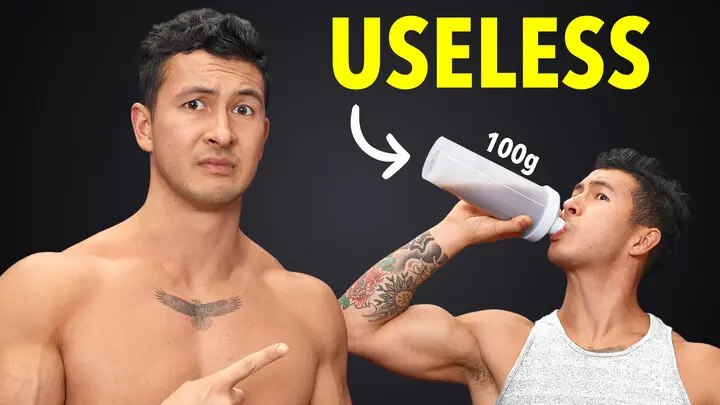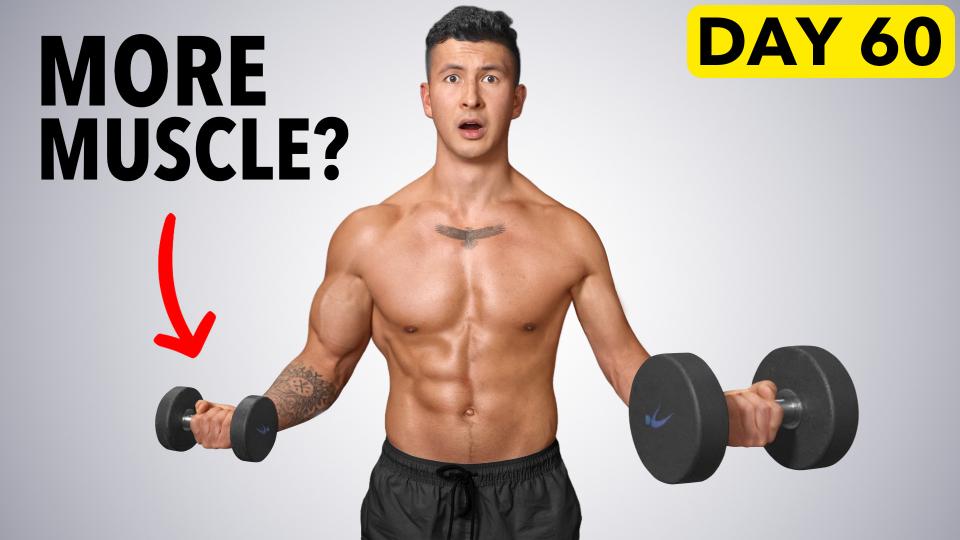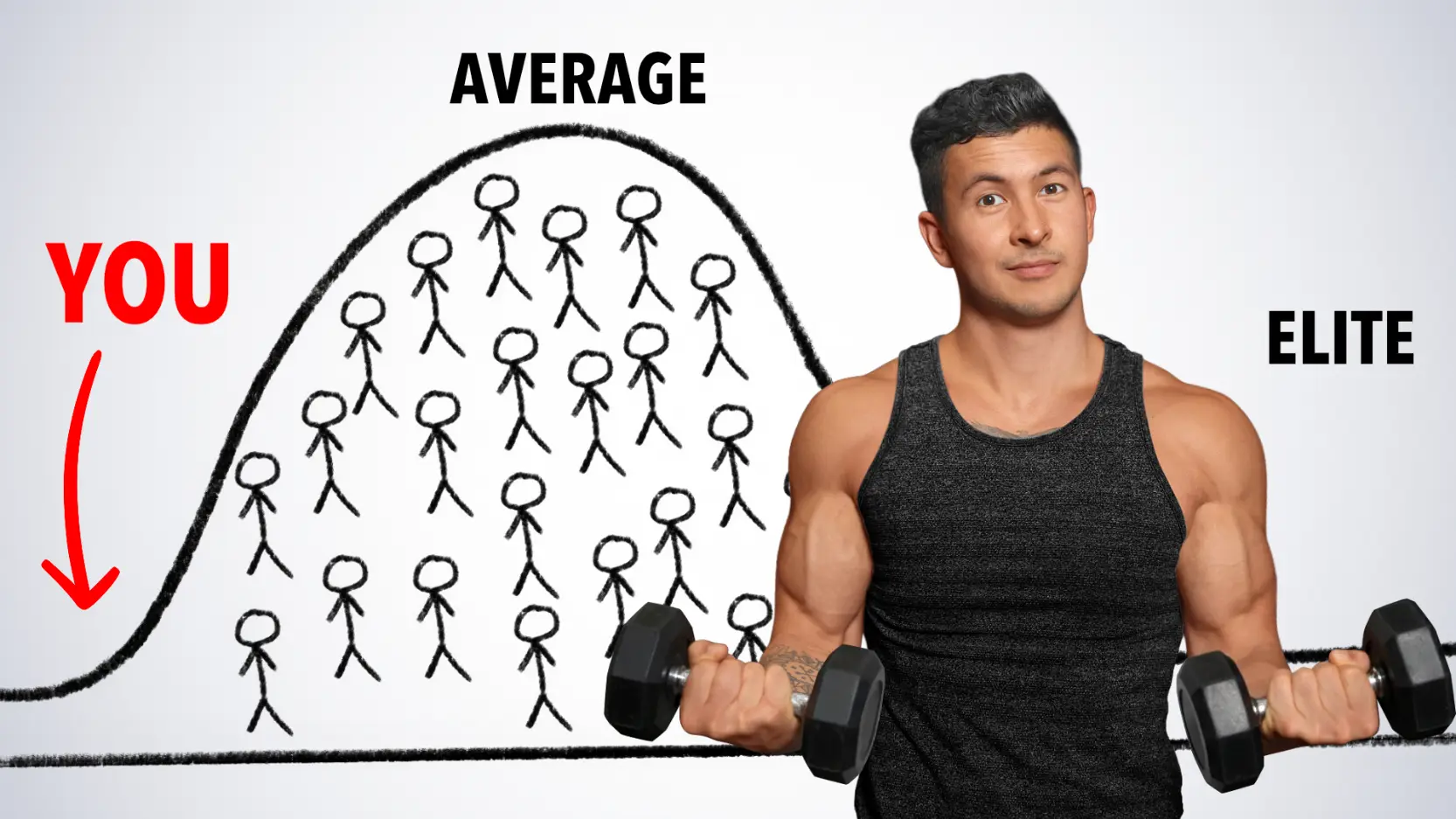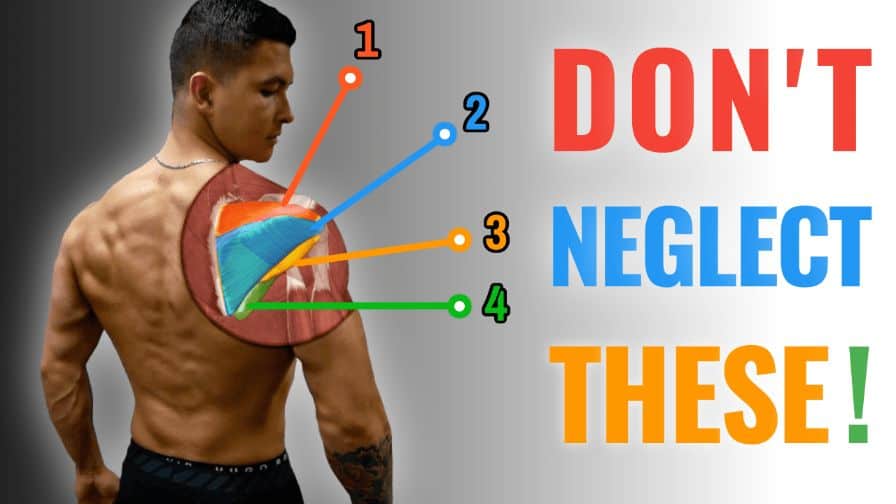
Top 3 Rotator Cuff Exercises (Fix Your Shoulder Pain)
If you want to lose your gains fast; get injured. In this article, you'll learn how to perform three rotator cuff exercises that will improve shoulder health and prevent injury.
Nothing will set you back more than injuries in your quest to build muscle and lose fat.
Shoulder injuries are one of the most common injuries lifters experience. Shoulder injuries tend to be the worst for your gains as they prevent you from doing any upper body exercises.
It's frustrating. That's why I never neglect to account for additional rotator cuff work in my programs. Removing the risk of shoulder injuries allows you to achieve your ideal physique in the most time-efficient manner. If that sounds good to you:
Click the button below to take my analysis quiz to discover the best program for you:
↓
How Can You Prevent Shoulder Injury?
The first step is to choose the right shoulder exercises, and more importantly, perform them correctly.
There are four muscles surrounding the shoulder joint, which collectively comprise the rotator cuff, as displayed in the following image.
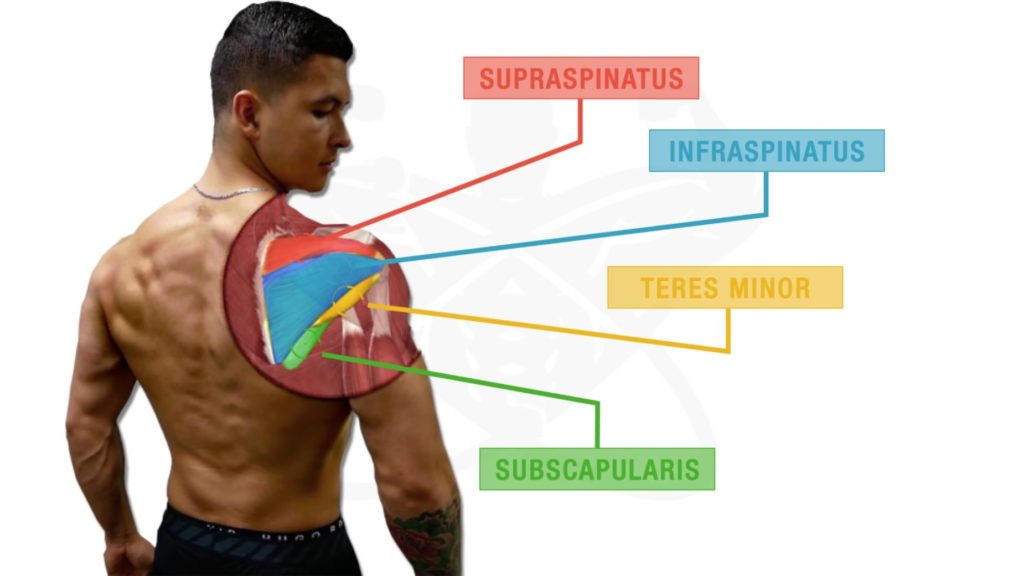
The rotator cuff is often unknowingly overlooked, which leads to underdevelopment and weakness of these small but important group of muscles.
Weakness in rotator cuff muscles increases your chances of injuring your shoulders. These small muscles collectively help to stabilize the shoulder joint throughout the motion of various pushing and pulling exercises.
When these muscles are weak, this causes increased instability in the shoulder during lifts. Instability often leads to shoulder pain, impingement, and eventually rotator cuff tears.
The Importance Of Rotator Cuff Exercises
Although these muscles are indirectly worked in many exercises, larger muscles such as the delts and chest drive most of the power of these exercises. With time, the dominance of larger muscles leads to imbalances in the shoulders over time.
What this implies is that you should be directly training and strengthening your rotator cuffs. By directly working your rotator cuffs, you'll better prevent shoulder injury. Doing so can also help to alleviate shoulder pain you currently have.
In some cases, directly working your rotator cuffs can benefit your strength on larger compounds pushing and pulling movements.
To strengthen these four key rotator cuff muscles, it's vital that you choose the right exercises, and perform them correctly.
In this article, with the help of science and our anatomical understanding of the rotator cuff muscles, I'll be showing you exactly how to perform three rotator cuff exercises.
1) Full Can Exercise (Supraspinatus)
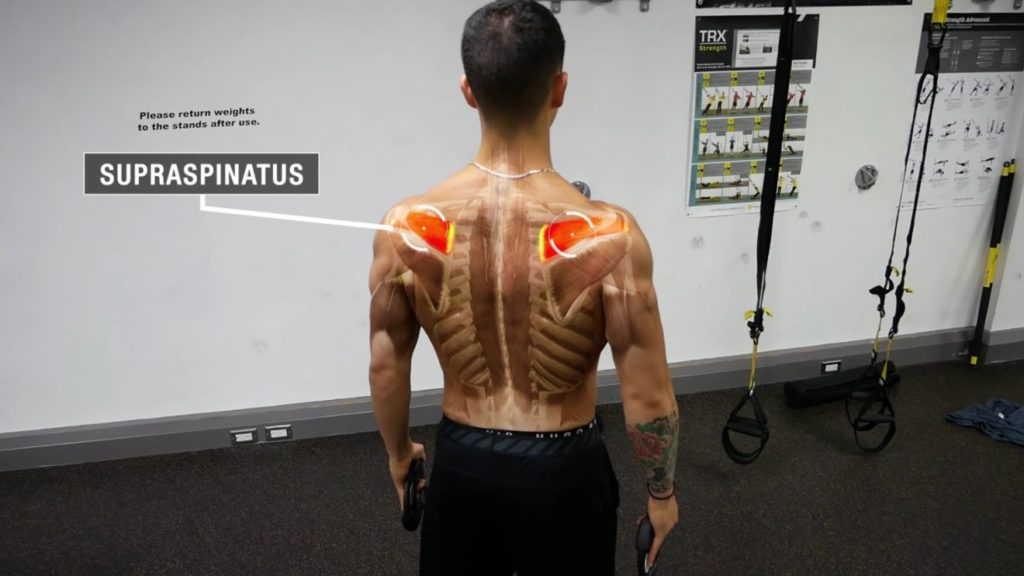
The first exercise is called the 'full can'.
The full can targets the supraspinatus muscle of the rotator cuff. This exercise is perfect for strengthening this muscle, as shown in a 2007 EMG analysis of various common exercises for the supraspinatus.
The full can elicits a high amount of EMG activity of the supraspinatus with the least amount of deltoid activity.

Minimal deltoid activation is important as this has been shown to reduce shear force placed on the shoulder joint.
Less deltoid activation also helps to strengthen the rotator cuff without having the deltoid compensate by overpowering it.
To get the most out of this exercise, it's crucial that you perform it correctly.
To Perform This Exercise:
- Start with your arms parallel to the floor.
- While keeping your elbow pinned to your side, slowly externally rotate outwards by pulling your hand up towards the ceiling.
- Return back down to parallel and repeat.
Be sure to point your thumbs up towards the ceiling and raise your arms up until you reach shoulder height. Research has shown that this is the range of motion where the supraspinatus is most active.
Pause at the top position for a second or two before powering down.
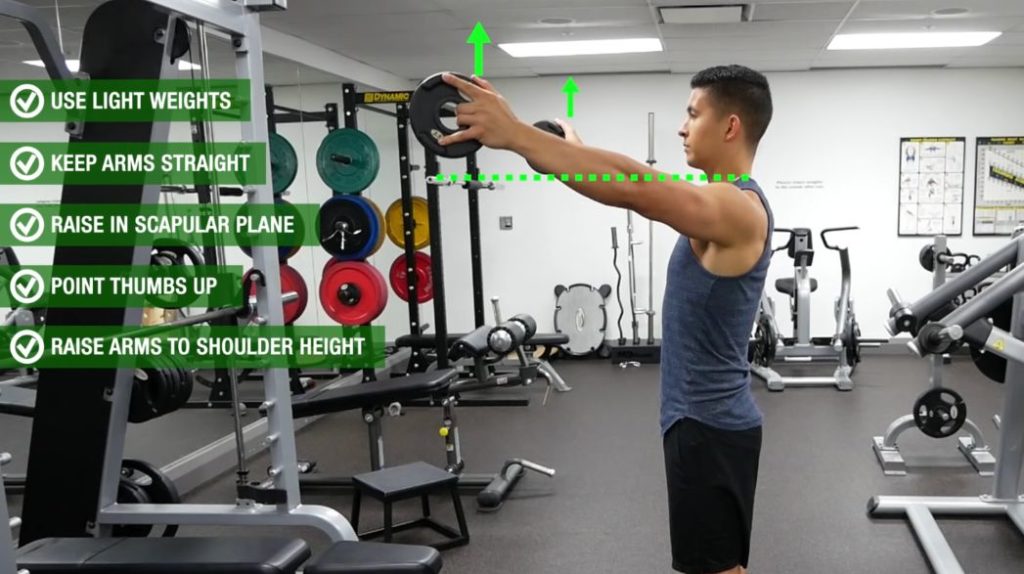
As you perform this exercise, be sure to keep your shoulder-blades pinned together and pulled down. Research indicates that this both increases joint space and allows you to strengthen the supraspinatus in a more mechanically advantageous position.
Additionally, as you raise, avoid shrugging your shoulders up and instead keep them down with your upper traps remaining as relaxed as possible throughout the movement.
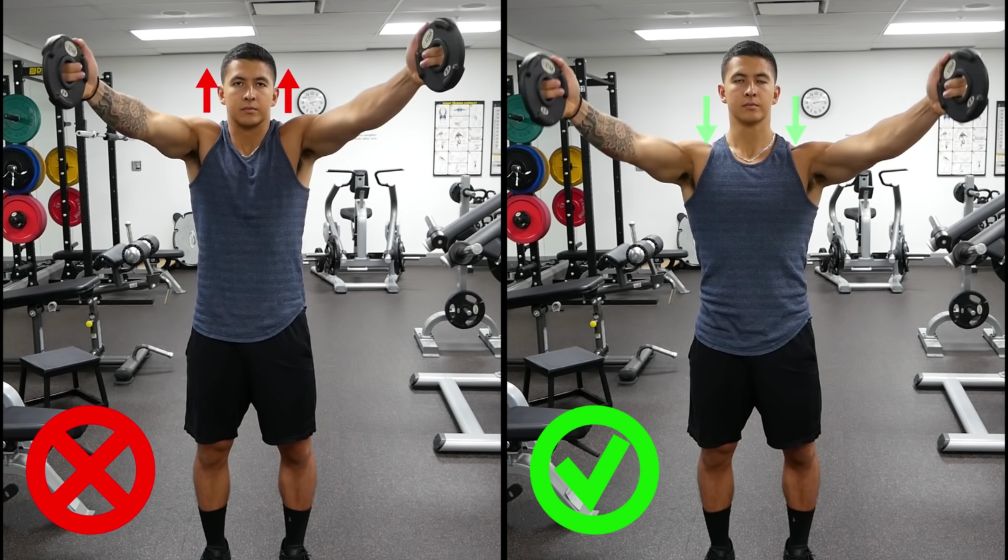
By implementing these tips, you'll ensure that you strengthen the supraspinatus while minimizing any compensations from other muscles groups.
I recommend starting out with a lighter weight for 2-3 sets of 15-20 reps, with a focus on form. Over time, you can progress with a slightly heavier weight.
It's important to remember that more weight isn't necessarily better for rotator cuff training. Focus on good form, and performing the exercise in a controlled manner.
2) Side-Lying External Rotation (Infraspinatus and Teres Minor)
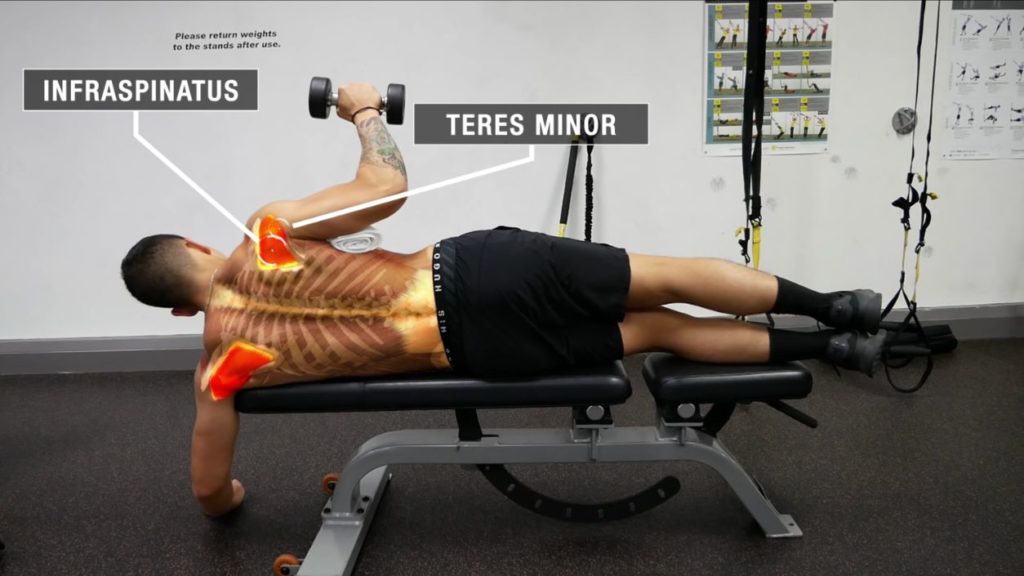
The next exercise is the side-lying external rotation movement.
The movement specifically targets the two posterior rotator cuff muscles at once; the infraspinatus and the teres minor.
This exercise is your best bet at targetting these rotator cuff muscles, as shown in the following two EMG graphs from a 2004 analysis of the rotator cuff muscles.
Side-lying external rotations elicit the highest infraspinatus and teres minor activation when compared to several other rotator cuff exercises. Furthermore, these external rotations cause the lowest strain on the shoulder joint.
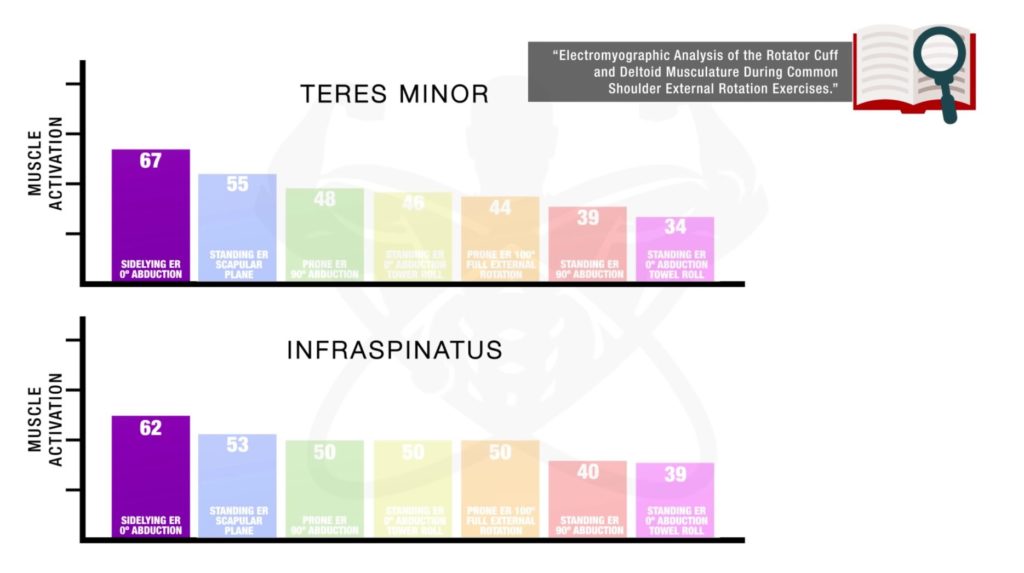
As with any exercise, and especially rotator cuff exercises, to reap the full benefits, it’s vital that you perform this movement correctly.
To begin, assume a side-lying position with a towel roll pinned between your top side arm and rib cage.
The towel is an important step since research has shown that adding a towel roll to the exercise boosts EMG activation of the 2 posterior rotator cuff muscles by roughly 20%. The purpose of using a towel is to minimize movement compensations from occurring.
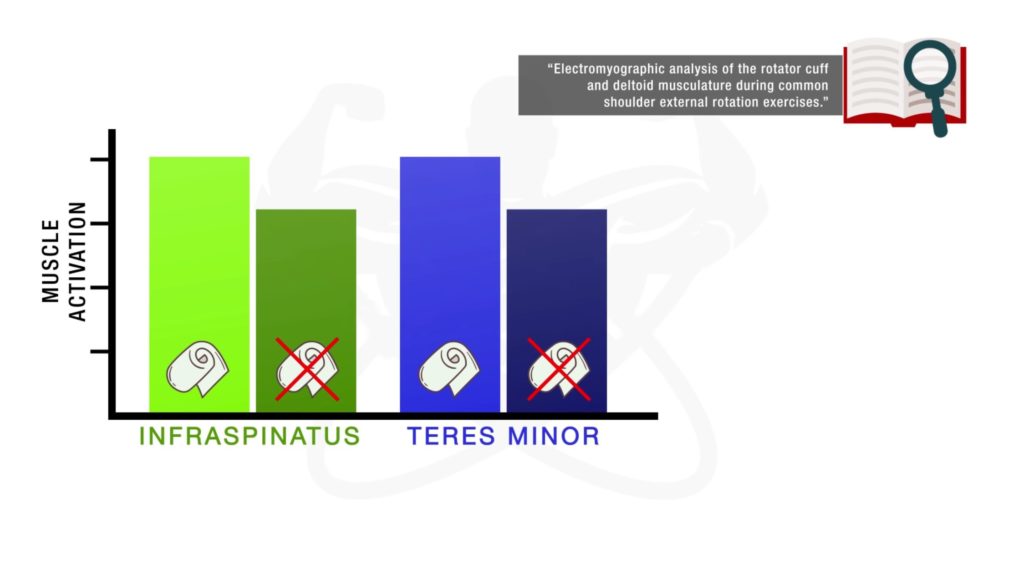
To Perform This Exercise:
- Pull your shoulder blades back and down and keep them locked in this position as you proceed with your set.
- Keep your shoulder blades back and down throughout the entire set.
- Start with your arms parallel to the floor and then slowly externally rotate outwards by pulling your hand up towards the ceiling, and then return back down to parallel and repeat.
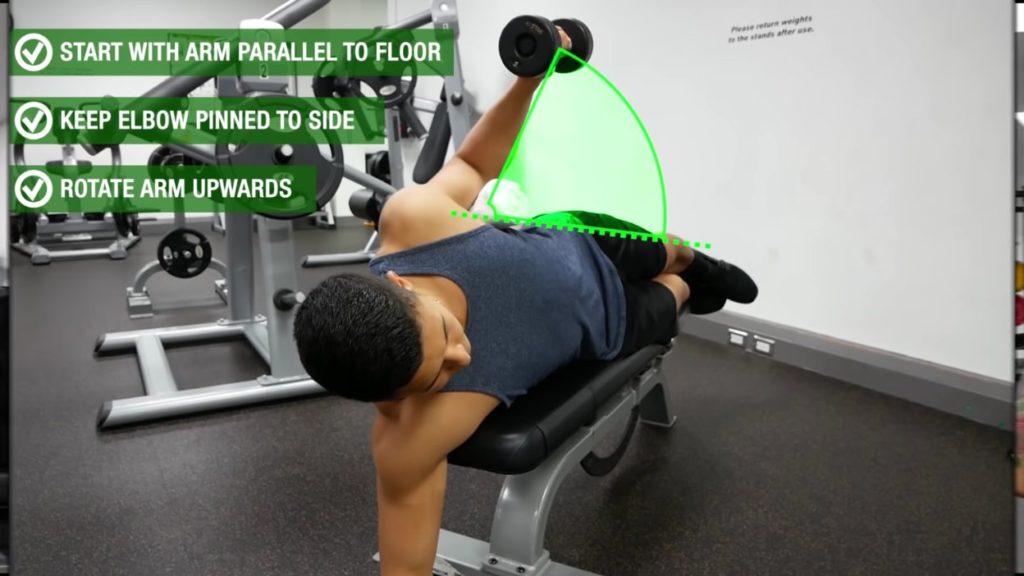
You’ll want to avoid letting your elbow drift up off your side as you raise the weight, as this will start involving more of the deltoids.
Instead, keep the elbow locked in place against the towel at your side as you perform each rep.
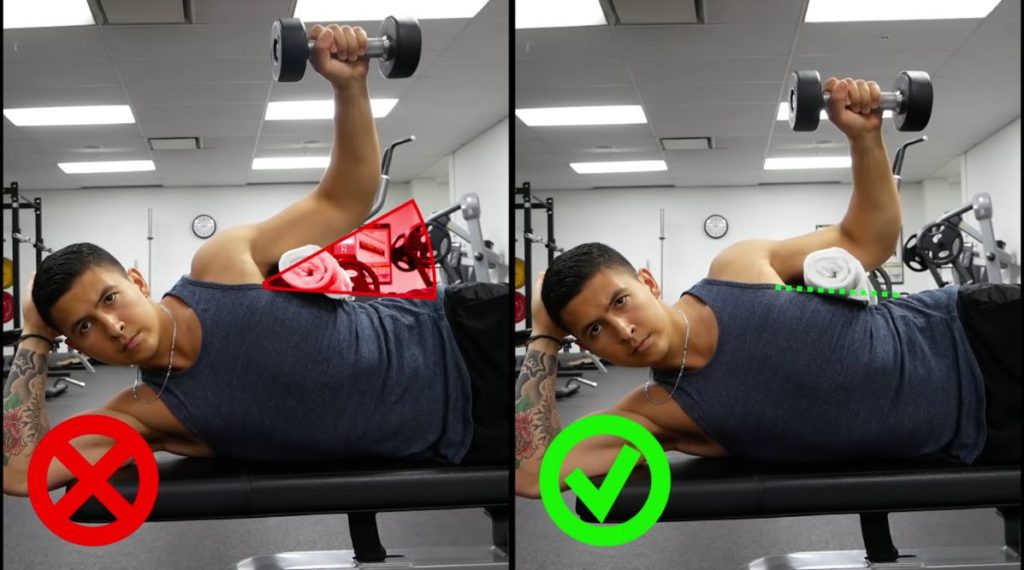
If you find it difficult to perform this movement or you feel pain at the top position, then you can start with partial reps. Perform partial reps in the 'pain-free zone' and progressively increase your range of motion over time.
I recommend starting out with a lighter weight for 2-3 sets of 15-20 reps each side, and then progressing from there as you get stronger. You can also perform this exercise with no weight at all.
If you appreciate science-based lifting tips, you'll absolutely love working with my team of highly-qualified trainers and nutritionists (plus myself!) In the process of guiding you through the process of achieving your dream physique in the time-efficient way possible, we'll also make sure you understand the science behind it all. Find out more here:
Click the button below to find out more about the 3-on-1 coaching program:
↓
3) External Rotation Press (Stability Exercise For Whole Rotator Cuff)
For the last exercise, we’re going to move onto something called the external rotation press.
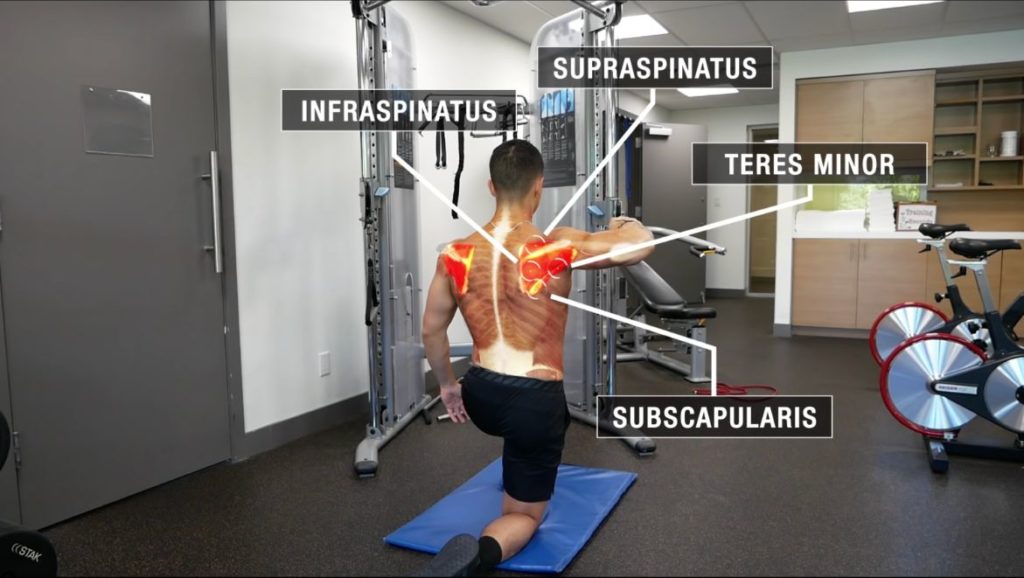
This exercise is going to challenge and strengthen all four rotator cuff muscles to a certain degree.
While the prior two exercises are fantastic for strengthening the various rotator cuff muscle, these exercises have limitations.
Many of the movements lifters perform in the gym take place above shoulder height in positions where the shoulder joint becomes more vulnerable to injury.
And so it’s vital to include the external rotation press to enhance your shoulder stability by training the rotator cuff muscles in a more functional manner.
To Perform This Exercise:
- Get down on one knee in an upright posture and grab either a band or a handle to a cable, and set it at roughly shoulder height.
- Pull the band towards you in a rowing motion with your elbow kept high at shoulder height.
Your hand should now be directly in front of your elbow with your arms parallel to the ground.
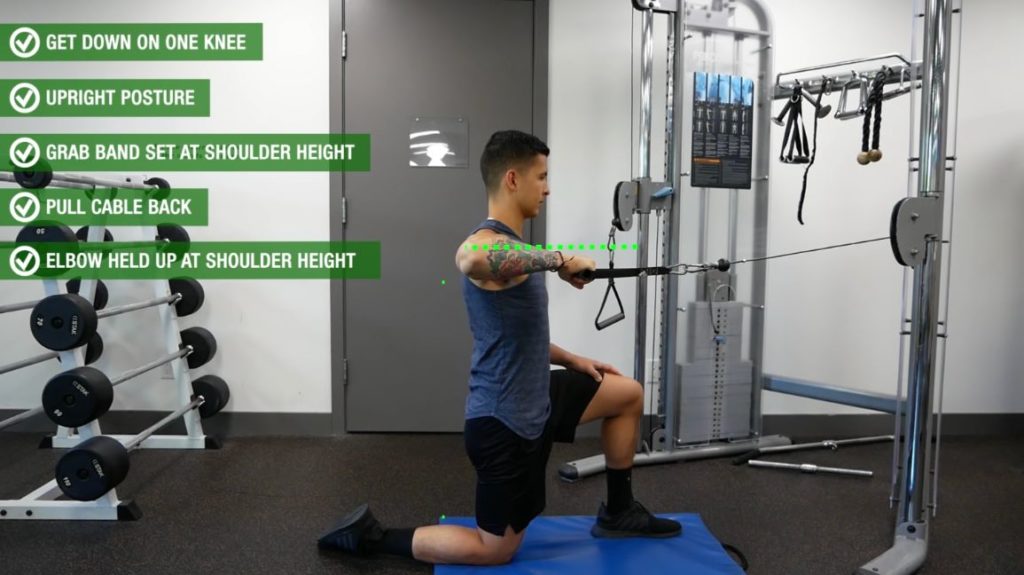
Hold this position briefly, and then externally rotate the shoulder by bringing the hand up towards the ceiling with the elbow still locked in the same place.
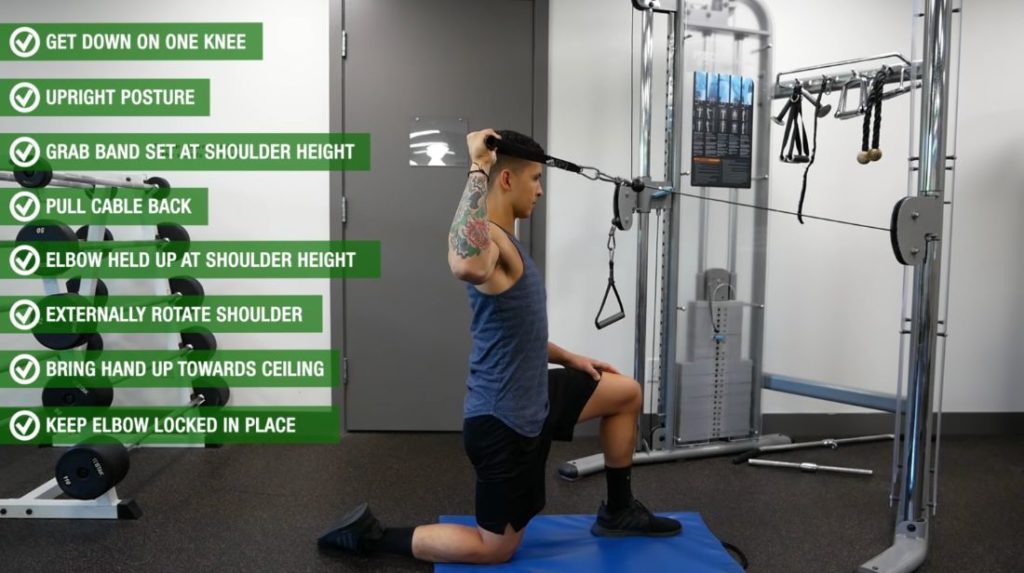
Next, press your arm up overhead and hold the top position briefly.
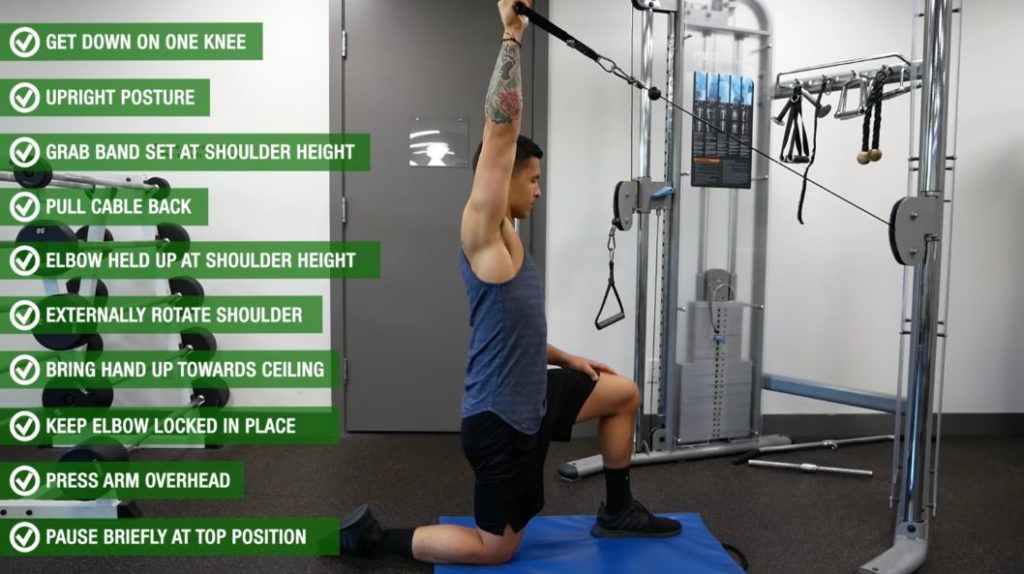
Then, reverse the pattern and repeat for more reps
Throughout this movement, your rotator cuff muscles will be working hard to counteract the resistance pulling your arm forward.
Try your best to avoid compensating by arching your lower back as you press up.
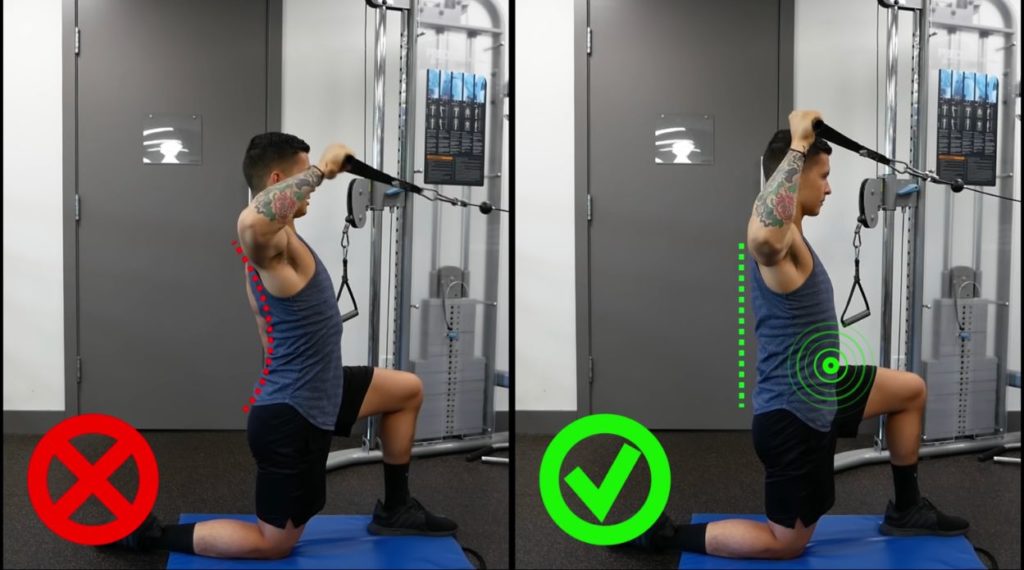
Instead, keep your core tight and contracted to maintain a neutral back as you perform the movement.
I recommend starting out with light resistance for roughly 2-3 sets of 10-15 reps. Maintain a focus on slow and controlled executions for each rep.
Focus On External Rotation
You may have noticed that with the previous exercise selection, the subscapularis hasn’t really been emphasized as much as the other three rotator cuff muscles have.
And this isn't by chance since the subscapularis is the only rotator cuff that performs an internal rotation of the shoulder.
Most people actually have too much internal rotation from poor posture and/or from the many pressing movements in the gym that involve internal rotation.
It's best not to emphasize the subscapularis as much. Instead, focus more on the other three rotator cuff muscles responsible for external rotation, which is exactly what we’ve done.
Here is the full rotator cuff strengthening routine that you can do using the exercises previously discussed:
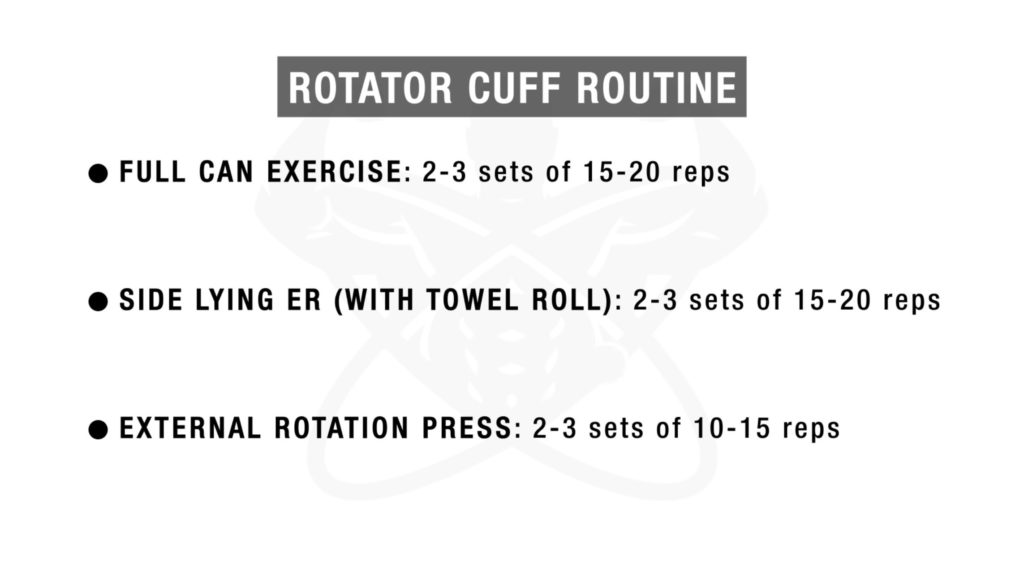
I recommend performing this routine 2-3 times per week.
It’s absolutely vital that you treat your rotator cuff muscles just like any other muscle group.
It can be easy to neglect your rotator cuffs, especially if you don't actually have any shoulder pain.
But this is a mistake.
Rotator cuff exercises can help alleviate rotator cuff injury and pain, but more importantly, rotator cuff exercises help to prevent rotator cuff issues.
As with any other exercise, ensure that you focus on progressing these exercises in some way on a regular basis, otherwise, you'll be wasting your time.
Download A Free PDF Of This Rotator Cuff Routine
This PDF will show you:
- How to safely progress these exercises over time.
- How much weight to use, and how to perform each exercise step-by-step.
Click here to download your free rotator cuff routine PDF
Don't let the size of the rotator cuff muscles fool you, as they are incredibly important.
It’s key muscle groups like the rotator cuff that are overlooked but really are what’s going to protect you from injury.
That’s exactly why within my Built With Science programs there’s a high priority placed on training key muscle groups like the rotator cuff. Rotator cuff exercises are integrated into your weekly weights routines so that you can effectively transform your body without developing imbalances in the process:
Click the button below to take my analysis quiz to discover the best program for you:
↓
I hope you enjoyed this article and found it useful! Don’t forget to give me a follow and connect with me on Instagram, Facebook, and Youtube as well, in order to stay up to date with my content. Cheers!


